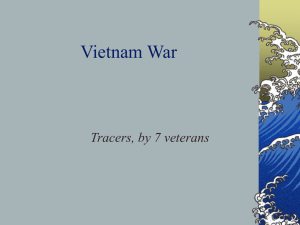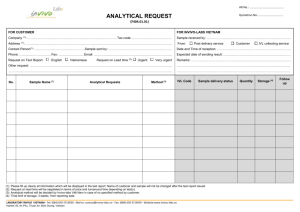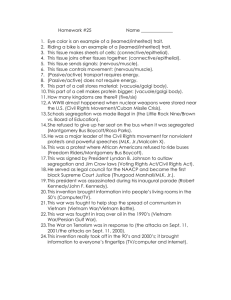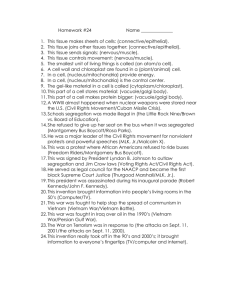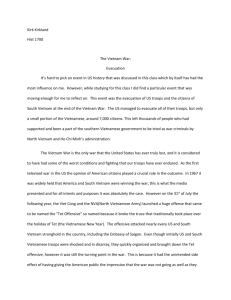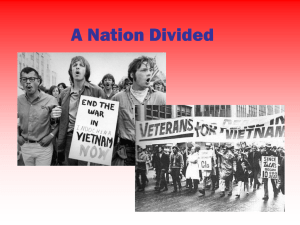Vietnam War
advertisement
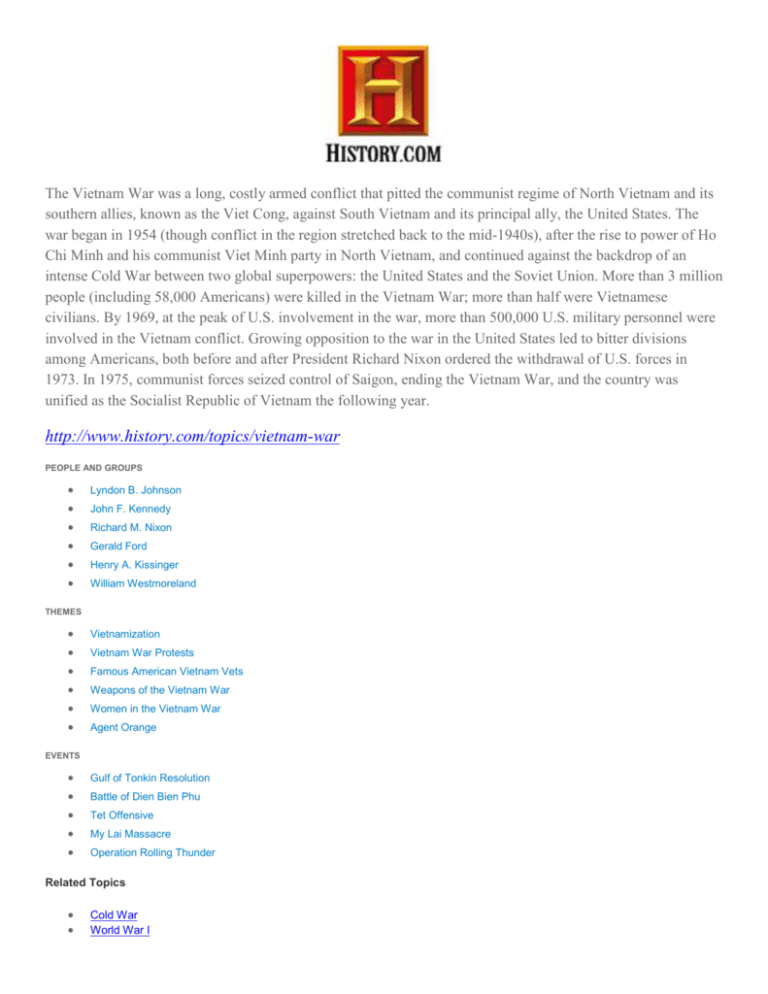
The Vietnam War was a long, costly armed conflict that pitted the communist regime of North Vietnam and its southern allies, known as the Viet Cong, against South Vietnam and its principal ally, the United States. The war began in 1954 (though conflict in the region stretched back to the mid-1940s), after the rise to power of Ho Chi Minh and his communist Viet Minh party in North Vietnam, and continued against the backdrop of an intense Cold War between two global superpowers: the United States and the Soviet Union. More than 3 million people (including 58,000 Americans) were killed in the Vietnam War; more than half were Vietnamese civilians. By 1969, at the peak of U.S. involvement in the war, more than 500,000 U.S. military personnel were involved in the Vietnam conflict. Growing opposition to the war in the United States led to bitter divisions among Americans, both before and after President Richard Nixon ordered the withdrawal of U.S. forces in 1973. In 1975, communist forces seized control of Saigon, ending the Vietnam War, and the country was unified as the Socialist Republic of Vietnam the following year. http://www.history.com/topics/vietnam-war PEOPLE AND GROUPS Lyndon B. Johnson John F. Kennedy Richard M. Nixon Gerald Ford Henry A. Kissinger William Westmoreland THEMES Vietnamization Vietnam War Protests Famous American Vietnam Vets Weapons of the Vietnam War Women in the Vietnam War Agent Orange EVENTS Gulf of Tonkin Resolution Battle of Dien Bien Phu Tet Offensive My Lai Massacre Operation Rolling Thunder Related Topics Cold War World War I Korean War World War II Recommended Articles Cold War The rivalry between the United States and the USSR, known as the Cold War, began after World War II and ended with the fall of the Soviet Union. Vietnam War Protests Opposition to American involvement in the Vietnam War grew steadily during the second half of the 1960s. Lyndon B. Johnson The 36th U.S. president, Lyndon B. Johnson took office in 1963 and is remembered for his social reform measures. Richard M. Nixon Richard Nixon, the 37th president of the United States, was the first to resign from office. Did You Know? According to a survey by the Veterans Administration, some 500,000 of the 3 million troops who served in Vietnam suffered from post-traumatic stress disorder, and rates of divorce, suicide, alcoholism and drug addiction were markedly higher among veterans. Contents Roots of the Vietnam War Vietnam War: U.S. Intervention Begins Vietnam War Escalates Strategy of Attrition in Vietnam Impact of the Tet Offensive on Vietnam War Vietnam War Ends: From Vietnamization to Withdrawal Legacy of the Vietnam War Roots of the Vietnam War During World War II, Japan invaded and occupied Vietnam, a nation on the eastern edge of the Indochina Peninsula in Southeast Asia that had been under French administration since the late 19th century. Inspired by Chinese and Soviet communism, Ho Chi Minh formed the Viet Minh, or the League for the Independence of Vietnam, to fight both Japan and the French colonial administration. Japan withdrew its forces in 1945, leaving the French-educated Emperor Bao Dai in control of an independent Vietnam. Ho's Viet Minh forces rose up immediately, seizing the northern city of Hanoi and declaring a Democratic Republic of Vietnam (DRV) with Ho as president. Seeking to regain control of the region, France backed Bao and set up the state of Vietnam (South Vietnam) in July 1949, with Saigon as its capital. Armed conflict continued until a decisive battle at Dien Bien Phu in May 1954 ended in French defeat by Viet Minh forces. The subsequent treaty negotiations at Geneva split Vietnam along the latitude known as the 17th parallel (with Ho in control in the North and Bao in the South) and called for nationwide elections for reunification to be held in 1956. In 1955, however, the strongly anticommunist Ngo Dinh Diem pushed Bao aside to become president of the Government of the Republic of Vietnam (GVN). Vietnam War: U.S. Intervention Begins With the Cold War intensifying, the United States hardened its policies against any allies of the Soviet Union, and by 1955 President Dwight D. Eisenhower had pledged his firm support to Diem and South Vietnam. With training and equipment from American military and police, Diem's security forces cracked down on Viet Minh sympathizers in the south, whom he derisively called Viet Cong (or Vietnamese Communist), arresting some 100,000 people, many of whom were tortured and executed. By 1957, the Viet Cong and other opponents of Diem's repressive regime began fighting back with attacks on government officials and other targets, and by 1959 they had begun engaging South Vietnamese Army forces in firefights. In December 1960, Diem's opponents within South Vietnam--both communist and non-communist--formed the National Liberation Front (NLF) to organize resistance to the regime. Though the NLF claimed to be autonomous and that most of its members were nonCommunist, many in Washington assumed it was a puppet of Hanoi. A team sent by President John F. Kennedy in 1961 to report on conditions in South Vietnam advised a build-up of American military, economic and technical aid in order to help confront the Viet Cong threat. Working under the "domino theory," which held that if one Southeast Asian country fell to communism, many would follow, Kennedy increased U.S. aid, though he stopped short of committing to a large-scale military intervention. By 1962, the U.S. military presence in South Vietnam had reached some 9,000 troops, compared with fewer than 800 during the 1950s. Vietnam War Escalates A coup by some of his own generals succeeded in toppling and killing Diem and his brother, Ngo Dinh Nhu, in November 1963, three weeks before Kennedy was assassinated in Dallas, Texas. The ensuing political instability in South Vietnam persuaded Kennedy's successor, Lyndon B. Johnson, and Secretary of Defense Robert McNamara to further increase U.S. military and economic support. The following August, after DRV torpedo boats attacked two U.S. destroyers in the Gulf of Tonkin, Johnson ordered the retaliatory bombing of military targets in North Vietnam. Congress soon passed the Gulf of Tonkin Resolution, which gave Johnson broad warmaking powers, and U.S. planes began regular bombing raids, codenamed Operation Rolling Thunder, the following February. In March 1965, Johnson made the decision--with solid support from the American public--to send U.S. combat forces into battle in Vietnam. By June, 82,000 combat troops were stationed in Vietnam, and General William Westmoreland was calling for 175,000 more by the end of 1965 to shore up the struggling South Vietnamese army. Despite the concerns of some of his advisers about this escalation, and about the entire war effort as well as a growing anti-war movement in the U.S., Johnson authorized the immediate dispatch of 100,000 troops at the end of July 1965 and another 100,000 in 1966. In addition to the United States, South Korea, Thailand, Australia and New Zealand also committed troops to fight in South Vietnam (albeit on a much smaller scale). Strategy of Attrition in Vietnam In contrast to the air attacks on North Vietnam, the U.S.-South Vietnamese war effort in the south was fought on the ground, largely under the command of General Westmoreland, in coordination with the government of General Nguyen Van Thieu in Saigon. In general, U.S. military forces in the region pursued a policy of attrition, aiming to kill as many enemy troops as possible rather than trying to secure territory. By 1966, large areas of South Vietnam had been designated as "free-fire zones," from which all innocent civilians were supposed to have evacuated and only enemy remained. Heavy bombing by B-52 aircraft or shelling made these zones uninhabitable, as refugees poured into camps in designated safe areas near Saigon and other cities. Even as the body count (at times exaggerated by U.S. and South Vietnamese authorities) mounted steadily, DRV and Viet Cong troops refused to stop fighting, encouraged by the fact that they could easily reoccupy lost territory. Meanwhile, supported by aid from China and the Soviet Union, North Vietnam strengthened its air defenses. By November 1967, the number of American troops in Vietnam was approaching 500,000, and U.S. casualties had reached 15,058 killed and 109,527 wounded. As the war stretched on, some soldiers came to mistrust their government's reasons for keeping them there, as well as Washington's claims that the war was being won. The later years of the war saw increased physical and psychological deterioration among American soldiers, including drug use, mutinies and attacks by soldiers against officers and noncommissioned officers. Bombarded by horrific images of the war on their televisions, Americans on the home front turned against the war as well: In October 1967, some 35,000 demonstrators staged a mass antiwar protest outside the Pentagon. Opponents of the war argued that civilians, not enemy combatants, were the primary victims and that the United States was supporting a corrupt dictatorship in Saigon. Impact of the Tet Offensive on Vietnam War By the end of 1967, Hanoi's communist leadership was growing impatient as well, and sought to strike a decisive blow aimed at forcing the better-supplied United States to give up hopes of success. On January 31, 1968, some 70,000 DRV forces under General Vo Nguyen Giap launched the Tet offensive (named for the lunar new year), a coordinated series of fierce attacks on more than 100 cities and towns in South Vietnam. Though taken by surprise, U.S. and South Vietnamese forces managed to strike back quickly, and the communists were unable to hold any of the targets for more than a day or two. Reports of the attacks stunned the U.S. public, however, especially after news broke that Westmoreland had requested an additional 200,000 troops. With his approval ratings dropping in an election year, Johnson called a halt to bombing in much of North Vietnam in March (though bombings continued in the south) and promised to dedicate the rest of his term to seeking peace rather than reelection. Johnson's new tack, laid out in a March 1968 speech, met with a positive response from Hanoi, and peace talks between the U.S. and North Vietnam opened in Paris that May. Despite the later inclusion of the South Vietnamese and the National Liberation Front (the political arm of the Viet Cong) the dialogue soon reached an impasse, and after an election campaign marred by violence, Republican Richard M. Nixon defeated Hubert Humphrey to win the White House. Vietnam War Ends: From Vietnamization to Withdrawal Nixon sought to deflate the antiwar movement by appealing to a "silent majority" of Americans who he believed supported the war effort. In an attempt to limit the volume of American casualties, he announced a program of withdrawing troops, increasing aerial and artillery bombardment and giving South Vietnamese control over ground operations. In addition to this policy, which he called "Vietnamization," Nixon continued public peace talks in Paris, adding higher-level secret talks conducted by Secretary of State Henry Kissinger beginning in the spring of 1968. The North Vietnamese continued to insist on complete U.S. withdrawal as a condition of peace, however, and the next few years would bring even more carnage, including the horrifying revelation that U.S. soldiers had massacred more than 400 unarmed civilians in the village of My Lai in March 1968. Anti-war protests continued to build as the conflict wore on. In 1968 and 1969, there were hundreds of anti-war marches and gatherings throughout the country. On November 15, 1969, the largest anti-war protest in American history took place in Washington, D.C., as over 250,000 Americans gathered peacefully, calling for withdrawal of American troops from Vietnam. The anti-war movement, which was particularly strong on college campuses, divided Americans bitterly. For some young people, the war symbolized a form of unchecked authority they had come to resent. For other Americans, opposing the government was considered unpatriotic and treasonous. As the first U.S. troops were withdrawn, those who remained became increasingly angry and frustrated, exacerbating problems with morale and leadership. Tens of thousands of soldiers received dishonorable discharges for desertion, and about 500,000 American men from 1965-73 became "draft dodgers," with many fleeing to Canada to evade conscription. Nixon ended draft calls in 1972, and instituted an all-volunteer army the following year. In 1970, a joint U.S-South Vietnamese operation invaded Cambodia, hoping to wipe out DRV supply bases there. The South Vietnamese then led their own invasion of Laos, which was pushed back by North Vietnam. The invasion of these countries, in violation of international law, sparked a new wave of protests on college campuses across America, including two at Kent State in Ohio and Jackson State in Mississippi during which National Guardsmen and police killed a total of six student protesters. By the end of June 1972, however, after another failed offensive into South Vietnam, Hanoi was finally willing to compromise. Kissinger and North Vietnamese representatives drafted a peace agreement by early fall, but leaders in Saigon rejected it, and in December Nixon authorized a number of bombing raids against targets in Hanoi and Haiphong. Known as the Christmas Bombings, the raids drew international condemnation. Legacy of the Vietnam War In January 1973, the United States and North Korea concluded a final peace agreement, ending open hostilities between the two nations. War between North and South Vietnam continued, however, until April 30, 1975, when DRV forces captured Saigon, renaming it Ho Chi Minh City (Ho himself died in 1969). The long conflict had affected an immense majority of the country’s population; in eight years of warfare, an estimated 2 million Vietnamese died, while 3 million were wounded and another 12 million became refugees. War had decimated the country's infrastructure and economy, and reconstruction proceeded slowly. In 1976, Vietnam was unified as the Socialist Republic of Vietnam, though sporadic violence continued over the next 15 years, including conflicts with neighboring China and Cambodia. Under a broad free market policy put in place in 1986, the economy began to improve, boosted by oil export revenues and an influx of foreign capital. Trade and diplomatic relations between Vietnam and the U.S. were resumed in the 1990s. In the United States, the effects of the Vietnam War would linger long after the last troops returned home in 1973. The nation spent more than $120 billion on the conflict in Vietnam from 1965-73; this massive spending led to widespread inflation, exacerbated by a worldwide oil crisis in 1973 and skyrocketing fuel prices. Psychologically, the effects ran even deeper. The war had pierced the myth of American invincibility, and had bitterly divided the nation. Many returning veterans faced negative reactions from both opponents of the war (who viewed them as having killed innocent civilians) and its supporters (who saw them as having lost the war), along with physical damage including the effects of exposure to the harmful chemical herbicide Agent Orange, millions of gallons of which had been dumped by U.S. planes on the dense forests of Vietnam. In 1982, the Vietnam Veterans Memorial was unveiled in Washington, D.C. On it were inscribed the names of 57,939 American armed forces killed or missing during the war; later additions brought that total to 58,200. Statistics about the Vietnam War "No event in American history is more misunderstood than the Vietnam War. It was misreported then, and it is misremembered now. Rarely have so many people been so wrong about so much. Never have the consequences of their misunderstanding been so tragic." [Nixon] The Vietnam War has been the subject of thousands of newspaper and magazine articles, hundreds of books, and scores of movies and television documentaries. The great majority of these efforts have erroneously portrayed many myths about the Vietnam War as being facts. [Nixon] Myth: Most American soldiers were addicted to drugs, guilt-ridden about their role in the war, and deliberately used cruel and inhumane tactics. The facts are: 91% of Vietnam Veterans say they are glad they served [Westmoreland] 74% said they would serve again even knowing the outcome [Westmoreland] There is no difference in drug usage between Vietnam Veterans and non veterans of the same age group (from a Veterans Administration study) [Westmoreland] Isolated atrocities committed by American soldiers produced torrents of outrage from antiwar critics and the news media while Communist atrocities were so common that they received hardly any attention at all. The United States sought to minimize and prevent attacks on civilians while North Vietnam made attacks on civilians a centerpiece of its strategy. Americans who deliberately killed civilians received prison sentences while Communists who did so received commendations. From 1957 to 1973, the National Liberation Front assassinated 36,725 South Vietnamese and abducted another 58,499. The death squads focused on leaders at the village level and on anyone who improved the lives of the peasants such as medical personnel, social workers, and schoolteachers. [Nixon] Atrocities - every war has atrocities. War is brutal and not fair. Innocent people get killed. Vietnam Veterans are less likely to be in prison - only 1/2 of one percent of Vietnam Veterans have been jailed for crimes. [Westmoreland] 97% were discharged under honorable conditions; the same percentage of honorable discharges as ten years prior to Vietnam [Westmoreland] 85% of Vietnam Veterans made a successful transition to civilian life. [McCaffrey] Vietnam veterans' personal income exceeds that of our non-veteran age group by more than 18 percent. [McCaffrey] Vietnam veterans have a lower unemployment rate than our non-vet age group. [McCaffrey] 87% of the American people hold Vietnam Vets in high esteem. [McCaffrey] Myth: Most Vietnam veterans were drafted. 2/3 of the men who served in Vietnam were volunteers. 2/3 of the men who served in World War II were drafted. [Westmoreland] Approximately 70% of those killed were volunteers. [McCaffrey] Many men volunteered for the draft so even some of the draftees were actually volunteers. Myth: The media have reported that suicides among Vietnam veterans range from 50,000 to 100,000 - 6 to 11 times the non-Vietnam veteran population. Mortality studies show that 9,000 is a better estimate. "The CDC Vietnam Experience Study Mortality Assessment showed that during the first 5 years after discharge, deaths from suicide were 1.7 times more likely among Vietnam veterans than non-Vietnam veterans. After that initial post-service period, Vietnam veterans were no more likely to die from suicide than non-Vietnam veterans. In fact, after the 5-year post-service period, the rate of suicides is less in the Vietnam veterans' group."[Houk] Myth: A disproportionate number of blacks were killed in the Vietnam War. 86% of the men who died in Vietnam were Caucasians, 12.5% were black, 1.2% were other races. (CACF and Westmoreland) Sociologists Charles C. Moskos and John Sibley Butler, in their recently published book "All That We Can Be," said they analyzed the claim that blacks were used like cannon fodder during Vietnam "and can report definitely that this charge is untrue. Black fatalities amounted to 12 percent of all Americans killed in Southeast Asia - a figure proportional to the number of blacks in the U.S. population at the time and slightly lower than the proportion of blacks in the Army at the close of the war."[All That We Can Be] Myth: The war was fought largely by the poor and uneducated. Servicemen who went to Vietnam from well-to-do areas had a slightly elevated risk of dying because they were more likely to be pilots or infantry officers. Vietnam Veterans were the best educated forces our nation had ever sent into combat. 79% had a high school education or better. [McCaffrey] Here are statistics from the Combat Area Casualty File (CACF) as of November 1993. The CACF is the basis for the Vietnam Veterans Memorial (The Wall): Average age of 58,148 killed in Vietnam was 23.11 years. (Although 58,169 names are in the Nov. 93 database, only 58,148 have both event date and birth date. Event date is used instead of declared dead date for some of those who were listed as missing in action) [CACF] Deaths Number Average Age Total 58,148 23.11 years Enlisted 50,274 22.37 years Officers 6,598 28.43 years Warrants 1,276 24.73 years E1 525 20.34 years USMC 0351 1,122 20.46 years 11B MOS 18,465 22.55 years One man killed in Vietnam was only 16 years old (RABER, PAUL J.) [CACF] The oldest man killed was 62 years old (TAYLOR, KENNA CLYDE). [CACF] 11,465 KIAs were less than 20 years old. [CACF] Myth: The average age of an infantryman fighting in Vietnam was 19. Assuming KIAs accurately represented age groups serving in Vietnam, the average age of an infantryman (MOS 11B) serving in Vietnam to be 19 years old is a myth, it is actually 22. None of the enlisted grades have an average age of less than 20. [CACF] The average man who fought in World War II was 26 years of age. [Westmoreland] Myth: The domino theory was proved false. The domino theory was accurate. The ASEAN (Association of Southeast Asian Nations) countries, Philippines, Indonesia, Malaysia, Singapore and Thailand stayed free of Communism because of the U.S. commitment to Vietnam. The Indonesians threw the Soviets out in 1966 because of America's commitment in Vietnam. Without that commitment, Communism would have swept all the way to the Malacca Straits that is south of Singapore and of great strategic importance to the free world. If you ask people who live in these countries that won the war in Vietnam, they have a different opinion from the American news media. The Vietnam War was the turning point for Communism. [Westmoreland] Democracy Catching On - In the wake of the Cold War, democracies are flourishing, with 179 of the world's 192 sovereign states (93%) now electing their legislators, according to the Geneva-based Inter-Parliamentary Union. In the last decade, 69 nations have held multi-party elections for the first time in their histories. Three of the five newest democracies are former Soviet republics: Belarus (where elections were first held in November 1995), Armenia (July 1995) and Kyrgyzstan (February 1995). And two are in Africa: Tanzania (October 1995) and Guinea (June 1995). [Parade Magazine] Myth: The fighting in Vietnam was not as intense as in World War II. The average infantryman in the South Pacific during World War II saw about 40 days of combat in four years. The average infantryman in Vietnam saw about 240 days of combat in one year thanks to the mobility of the helicopter. One out of every 10 Americans who served in Vietnam was a casualty. 58,169 were killed and 304,000 wounded out of 2.59 million who served. Although the percent who died is similar to other wars, amputations or crippling wounds were 300 percent higher than in World War II. 75,000 Vietnam veterans are severely disabled. [McCaffrey] MEDEVAC helicopters flew nearly 500,000 missions. Over 900,000 patients were airlifted (nearly half were American). The average time lapse between wounding to hospitalization was less than one hour. As a result, less than one percent of all Americans wounded who survived the first 24 hours died. [VHPA 1993] The helicopter provided unprecedented mobility. Without the helicopter it would have taken three times as many troops to secure the 800 mile border with Cambodia and Laos (the politicians thought the Geneva Conventions of 1954 and the Geneva Accords or 1962 would secure the border) [Westmoreland] More helicopter facts: Approximately 12,000 helicopters saw action in Vietnam (all services). [VHPA databases] Army UH-1's totaled 9,713,762 flight hours in Vietnam between October 1966 and the end of American involvement in early 1973. [VHPA databases] Army AH-1G's totaled 1,110,716 flight hours in Vietnam. [VHPA databases] We believe that the Huey along with the Huey Cobra have more combat flight time than any other aircraft in the history of warfare assuming you count actual hostile fire exposure versus battle area exposure. As an example, heavy bombers during World War II most often flew missions lasting many hours with only 10 to 20 minutes of that time exposed to hostile fire. Helicopters in Vietnam seldom flew above 1,500 feet which is traffic pattern altitude for bombers and were always exposed to hostile fire even in their base camps. Myth: Air America, the airline operated by the CIA in Southeast Asia, and its pilots were involved in drug trafficking. The 1990 unsuccessful movie "Air America" helped to establish the myth of a connection between Air America, the CIA, and the Laotian drug trade. The movie and a book the movie was based on contend that the CIA condoned a drug trade conducted by a Laotian client; both agree that Air America provided the essential transportation for the trade; and both view the pilots with sympathetic understanding. American-owned airlines never knowingly transported opium in or out of Laos, nor did their American pilots ever profit from its transport. Yet undoubtedly every plane in Laos carried opium at some time, unknown to the pilot and his superiors. For more information see http://www.air-america.org Facts about the fall of Saigon Myth: The American military was running for their lives during the fall of Saigon in April 1975. The picture of a Huey helicopter evacuating people from the top of what was billed as being the U.S. Embassy in Saigon during the last week of April 1975 during the fall of Saigon helped to establish this myth. This famous picture is the property of UPI Corbus-Bettman Photo Agency. It is one of 42 pictures of this helicopter that UPI photographer, Hubert Van Es took on 29 April 1975 from UPI's offices on the top floor of the Saigon Hotel which was several blocks from the Pittman Apartments. [People] Here are some facts to clear up that poor job of reporting by the news media. It was a "civilian" (Air America) Huey not Army or Marines. It was NOT the U.S. Embassy. The building is the Pittman Apartments, a 10 story building where the CIA station chief and many of his officers lived, located at 22 Ly Tu Trong St. The U.S. Embassy and its helipad were much larger. The platform is the top of the elevator shaft for the building and was not designed as a helipad. [People] The evacuees were Vietnamese not American military. Two high ranking Vietnamese where among those taken that day to Tan Son Nhut airport, General Tran Van Don and the head of the secret police Tran Kim Tuyen. Both immigrated to Europe and both have since died. [People] The person who can be seen aiding the refugees was CIA operations officer, Mr. O.B. Harnage, who is now retired in Arizona. The pilots who were flying this helicopter, tail number N4 7004, were Bob Caron who lives in Florida and Jack "Pogo" Hunter who died in 1997. [People] Another famous picture. Myth: Kim Phuc, the little nine year old Vietnamese girl running naked from the napalm strike near Trang Bang on 8 June 1972, was burned by Americans bombing Trang Bang. No American had involvement in this incident near Trang Bang that burned Phan Thi Kim Phuc. The planes doing the bombing near the village were VNAF (Vietnam Air Force) and were being flown by Vietnamese pilots in support of South Vietnamese troops on the ground. The Vietnamese pilot who dropped the napalm in error is currently living in the United States. Even the AP photographer, Nick Ut, who took the picture was Vietnamese. The incident in the photo took place on the second day of a three day battle between the North Vietnamese Army (NVA) who occupied the village of Trang Bang and the ARVN (Army of the Republic of Vietnam) who were trying to force the NVA out of the village. Recent reports in the news media that an American commander ordered the air strike that burned Kim Phuc are incorrect. There were no Americans involved in any capacity. "We (Americans) had nothing to do with controlling VNAF," according to Lieutenant General (Ret) James F. Hollingsworth, the Commanding General of TRAC at that time. Also, it has been incorrectly reported that two of Kim Phuc's brothers were killed in this incident. They were Kim's cousins not her brothers. Myth: The United States lost the war in Vietnam. The American military was not defeated in Vietnam. The American military did not lose a battle of any consequence. From a military standpoint, it was almost an unprecedented performance. (Westmoreland quoting Douglas Pike, a professor at the University of California, Berkley a renowned expert on the Vietnam War)[Westmoreland] This included Tet 68, which was a major military defeat for the VC and NVA. THE UNITED STATES DID NOT LOSE THE WAR IN VIETNAM, THE SOUTH VIETNAMESE DID after the U.S. Congress cut off funding. The South Vietnamese ran out of fuel, ammunition and other supplies because of a lack of support from Congress while the North Vietnamese were very well supplied by China and the Soviet Union. Facts about the end of the war: The fall of Saigon happened 30 April 1975, two years AFTER the American military left Vietnam. The last American troops departed in their entirety 29 March 1973. How could we lose a war we had already stopped fighting? We fought to an agreed stalemate. The peace settlement was signed in Paris on 27 January 1973. It called for release of all U.S. prisoners, withdrawal of U.S. forces, limitation of both sides' forces inside South Vietnam and a commitment to peaceful reunification. [1996 Information Please Almanac] The 140,000 evacuees in April 1975 during the fall of Saigon consisted almost entirely of civilians and Vietnamese military, NOT American military running for their lives. [1996 Information Please Almanac] There were almost twice as many casualties in Southeast Asia (primarily Cambodia) the first two years after the fall of Saigon in 1975 then there were during the ten years the U.S. was involved in Vietnam. [1996 Information Please Almanac] POW-MIA Issue (unaccounted-for versus missing in action) Politics & People, On Vietnam, Clinton Should Follow a Hero's Advice, contained this quote about Vietnam, there has been "the most extensive accounting in the history of human warfare" of those missing in action. While there are still officially more than 2,200 cases, there now are only 55 incidents of American servicemen who were last seen alive but aren't accounted for. By contrast, there still are 78,000 unaccounted-for Americans from World War II and 8,100 from the Korean conflict. "The problem is that those who think the Vietnamese haven't cooperated sufficiently think there is some central repository with answers to all the lingering questions," notes Gen. John Vessey, the former chairman of the Joint Chiefs of Staff and the Reagan and Bush administration's designated representative in MIA negotiations. "In all the years we've been working on this we have found that's not the case." [The Wall Street Journal] More realities about war: Post Traumatic Stress Disorder (PTSD) - it was not invented or unique to Vietnam Veterans. It was called "shell shock" and other names in previous wars. An automobile accident or other traumatic event also can cause it. It does not have to be war related. The Vietnam War helped medical progress in this area. Myth: Agent Orange poisoned millions of Vietnam veterans. Over the ten years of the war, Operation Ranch Hand sprayed about eleven million gallons of Agent Orange on the South Vietnamese landscape. (the herbicide was called "orange" in Vietnam, not Agent Orange. That sinister-sounding term was coined after the war) Orange was sprayed at three gallons per acre that was the equivalent of .009 of an ounce per square foot. When sprayed on dense jungle foliage, less that 6 percent ever reached the ground. Ground troops typically did not enter a sprayed area until four to six weeks after being sprayed. Most Agent Orange contained .0002 of 1 percent of dioxin. Scientific research has shown that dioxin degrades in sunlight after 48 to 72 hours; therefore, troops exposure to dioxin was infinitesimal. [Burkett] See also The History of the Ranch Hand Epidemiologic Investigation. Restraining the military in Vietnam in hindsight probably prevented a nuclear war with China or Russia. The Vietnam War was shortly after China got involved in the Korean war, the time of the Cuban missile crisis, Soviet aggression in Eastern Europe and the proliferation of nuclear bombs. In all, a very scary time for our country. SOURCES [Nixon] No More Vietnams by Richard Nixon [Parade Magazine] August 18, 1996 page 10. [CACF] (Combat Area Casualty File) November 1993. (The CACF is the basis for the Vietnam Veterans Memorial, i.e. The Wall), Center for Electronic Records, National Archives, Washington, DC [All That We Can Be] All That We Can Be by Charles C. Moskos and John Sibley Butler [Westmoreland] Speech by General William C. Westmoreland before the Third Annual Reunion of the Vietnam Helicopter Pilots Association (VHPA) at the Washington, DC Hilton Hotel on July 5th, 1986 (reproduced in a Vietnam Helicopter Pilots Association Historical Reference Directory Volume 2A) [McCaffrey] Speech by Lt. Gen. Barry R. McCaffrey, (reproduced in the Pentagram, June 4, 1993) assistant to the Chairman of the Joint Chiefs of Staff, to Vietnam veterans and visitors gathered at "The Wall", Memorial Day 1993. [Houk] Testimony by Dr. Houk, Oversight on Post-Traumatic Stress Disorder, 14 July 1988 page 17, Hearing before the Committee on Veterans' Affairs United States Senate one hundredth Congress second session. Also "Estimating the Number of Suicides Among Vietnam Veterans" (Am J Psychiatry 147, 6 June 1990 pages 772776) [The Wall Street Journal] The Wall Street Journal, 1 June 1996 page A15. [VHPA 1993] Vietnam Helicopter Pilots Association 1993 Membership Directory page 130. [VHPA Databases] Vietnam Helicopter Pilots Association Databases. [1996 Information Please Almanac] 1995 Information Please Almanac Atlas & Yearbook 49th edition, Houghton Mifflin Company, Boston & New York 1996, pages 117, 161 and 292. [Burkett] Stolen Valor: How the Vietnam Generation was Robbed of its Heroes and its History by B.G. Burkett and Glenna Whitley, Verity Press, Inc., Dallas, TX, 1998. Book review. [People.com] Vietnam 25 Years Later, by Joe Treen, People.com, 21 April 2000. Other references: VC and NVA murders Statistics Of Vietnamese Democide Estimates, Calculations, And Sources by R.J. Rummel Updated: 2 June 2008 Gary Roush 242 ASHC Muleskinners Information by: roush@vhpa.org Return to the VHFCN Homepage
![vietnam[1].](http://s2.studylib.net/store/data/005329784_1-42b2e9fc4f7c73463c31fd4de82c4fa3-300x300.png)



